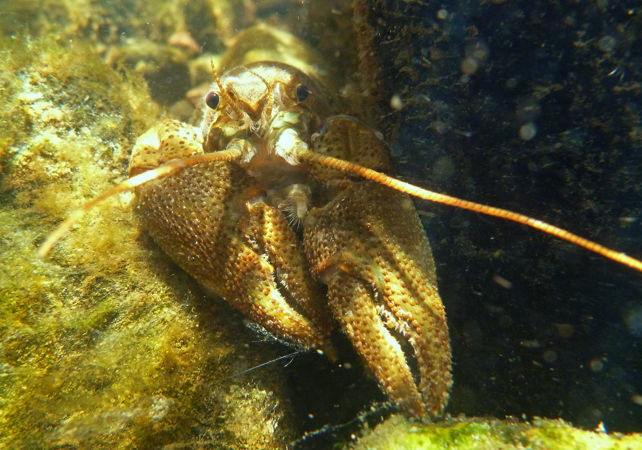From the edge of extinction: A Wales wide conservation effort to save our native crayfish

Crayfish conservation is accelerating across Wales as organisations work together to protect the white-clawed crayfish, a native species at risk of disappearing from Welsh rivers.
Once thriving across Wales, the white-clawed crayfish is now endangered and faces extinction due to increasing pressures from invasive species like the North American signal crayfish, pollution, climate change and ongoing habitat loss.
To help combat their decline in Wales and boost remaining populations, conservationists are working to establish Ark sites, which are locations where new populations of white-clawed crayfish can safely be established.
Science meets action in mid Wales rivers
In 2021, a pivotal study funded by Natural Resources Wales (NRW) and led by Montgomeryshire Wildlife Trust, kickstarted a collaborative conservation initiative to conserve native, white-clawed crayfish in North Powys.
As part of the study, a working group was established with NRW, Montgomeryshire Wildlife Trust the Severn Rivers Trust, The Canal and River Trust, North Wales Wildlife Trust WAREN Project, and Aberystwyth University to drive forward monitoring, research, and on-the-ground recovery actions.
Tracking change through science
Ongoing environmental DNA (eDNA) sampling in the River Banwy is helping to map crayfish populations using water samples. This technique is vital for understanding the current distribution of crayfish and the presence of crayfish plague across three of Montgomeryshire’s river catchments.
Captive rearing for the future
At NRW’s Hatchery in Cynrig, officers are undertaking a programme of work to collect berried females (crayfish carrying eggs) to rear the juveniles in safe, controlled conditions. In the wild, the survival rate to maturation is less than 10% while in the hatchery, this can raise to around 90% . The aim is to release the juvenile crayfish into Ark sites in late summer 2025, a major milestone in a four-year partnership to protect one of Montgomeryshire’s last strongholds for white-clawed crayfish.
To date, the hatchery has successfully reared over 7,000 crayfish, supporting conservation efforts at multiple sites across Wales and England.
South Wales: Building safe havens for a native species
In south Wales, NRW officers are using artificial refuge traps as a way to monitor crayfish populations in Monmouthshire.
The artificial traps, placed in a watercourse in March, mimic natural refuges using a series of open ended pipes. They are designed to allow the crayfish to come and go as they please, using the ‘trap’ as a place of shelter.
In late May, officers returned to the site to check the traps and were encouraged to find over 100 white-clawed crayfish, using the traps and under stones, including twenty females carrying eggs
The female crayfish will be taken to NRW’s hatchery, to allow the eggs to hatch, before being returned to the water course in Monmouthshire. The juveniles will stay at the hatchery for approximately two years before being released in to a suitable Ark site, increasing their chances of survival.
Oliver Brown, Aquaculture officer for Natural Resources Wales said:
The white-clawed crayfish plays a crucial role in our river ecosystems and is an indicator of clean, healthy waters. Sadly, well over half of the UK’s population has been lost since the 1970s, with local extinctions in many river basins.
Working with partners, we’re building a coordinated, long-term programme to understand where our native crayfish are and give them a fighting chance of survival.
By giving young crayfish a head start and creating Ark sites, we’re giving this species a second chance. But we can’t do it alone. We need help from anglers, walkers, and everyone who spends time in or near rivers. The future of the species depends on what we all do next.
Tammy Stretton, Conservation Officer, Montgomeryshire Wildlife Trust said:
The challenges facing white-clawed crayfish are diverse and complicated; the Montgomeryshire Crayfish Working Group has proved vital for ensuring a future for this threatened species in mid Wales. Working together not only with other eNGOs, but also NRW and Aberystwyth University, we have been able to take collective action which would not be possible otherwise.
We have the knowledge and expertise in the group to respond swiftly to latest information and research and make efficient use of limited resources. This group provides a great model for collaborative working towards a common goal.
You can play a part in helping to protect this amazing species, too.
By practising good biosecurity - especially the Check, Clean, Dry method - you can help prevent the spread of invasive species in our waters. Remember to:
CHECK: Inspect your equipment, boat, and clothing for any mud, plants, or aquatic animals after leaving the water. Leave anything you find behind at the site.
CLEAN: Thoroughly clean your equipment as soon as possible, focusing on areas that may be damp or difficult to reach.
DRY: Allow everything to dry completely before using it again - some invasive species can survive for over two weeks in damp conditions.
If you spot a crayfish, you can record it by taking a photo and uploading the information to Home | iRecord.
Please take care to avoid disturbing white-clawed crayfish as it is illegal to do so without a licence.
If you see dead crayfish, you can report this along with the location, to the NRW incident communication line on 0300 065 3000 or by using the online report it form Natural Resources Wales / Report an incident
